50W COB 30V-36V LED minitest from China - will it really be 50W?

Recently, I found an offer to sell a COB LED module with a power of 50W. I decided to check whether the given parameters really correspond to reality - below I put the results of my test.
50W COB LED module purchase
I found the diode on eBay under the slogan 50W LED Chip COB 30V-36V Cool white Integrated Bright Bulb beads for Floodlight for less than 2 euro:
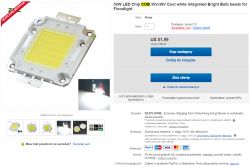
The seller is of course from China.
COB in its name is an abbreviation of "Chip on board", which means that this module is a few or more LEDs in one housing as a single module.
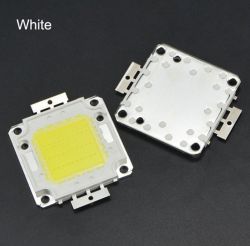
The module has the following dimensions:

The seller provides the following parameters:
Quote:Power: 50W
Working voltage: 30-36V
Current: 1500mA +- 5%
Brightness: 4700LM
Dimensions: 52mmX40mm
Knowing the aspirations of some sellers to overestimate the parameters of their products, I decided to see if this diode actually reaches 50W - the results below.
Test environment (TP-1603 power supply)
Good cooling is necessary for such an LED module - even if we want to run it only for a moment. It shouldn't be turned on without a heat sink at all.
For this reason, I also chose one of the larger heat sinks I had at hand and drilled four holes in it for mounting the module (although this heat sink should be much bigger , especially for continuous operation):


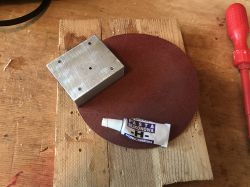
I used thermal paste to improve the contact between the LED and the heat sink.
Of course, this module is powered by direct current. The poles of the module are marked on its housing - just take a look. I soldered wires of the appropriate colors to the leads:
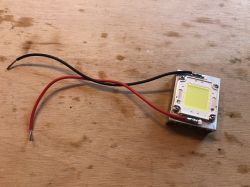

I used the TP-1603 laboratory power supply to power the diode. It offers voltage and current regulation in the range of 0-60V and 0-3A. Additionally (in order to verify the measurements) I used a UT210E clamp meter and a BM857s multimeter to measure the voltage:

Voltage / current measurement results
Such LEDs should be energized current source , that is, constant current, not voltage. This is because the voltage drop across a diode changes with its temperature, which if powered from a voltage source would result in a change in current as it heats up, which could eventually burn it.
That's why I used my power supply as a current source.
I gradually increased the diode current. The diode started to glow slightly at 0.01A current and 25.5V voltage.
I quickly realized that this LED was REALLY BRIGHT. Even at lower tensions, a brief glance at it makes us see a 'trace' of its brightness in front of our eyes. I advise against anyone irresponsible experiments with such strong light sources, you can damage your eyesight.
I allowed myself to pull the test up to 2A with the full awareness that it might end up damaging the module.
Between subsequent tests, I took breaks so that the heat sink could cool down.
Below are photos of measurements:
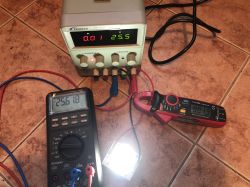
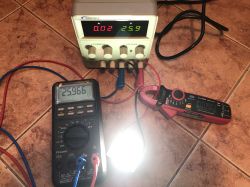
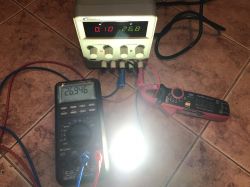
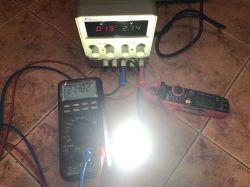
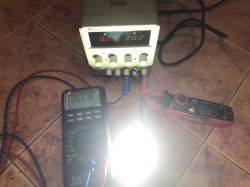

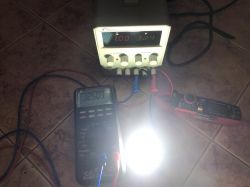
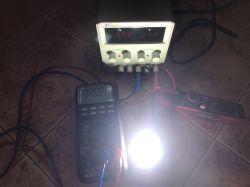

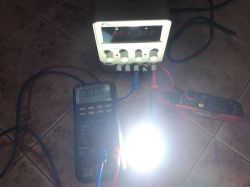
I gave the measurement results to the table:
| Current [A] | Voltage [V] | Power [W] |
| 0.01 | 25.5 | 0.255 |
| 0.02 | 25.9 | 0.518 |
| 004 | 26.2 | 1.048 |
| 0.1 | 26.8 | 2.68 |
| 0.15 | 27.4 | 4.11 |
| 0.25 | 28.2 | 7.05 |
| 0.5 | 29.9 | 14.95 |
| 1 | 32.4 | 32.4 |
| 1.5 | 34.4 | 51.6 |
| 1.75 | 35.3 | 61.775 |
| 2 | 36.2 | 72.4 |
Of course, if you observe the diode for longer, you can see that the voltage at a given constant current value changes - this is what I mentioned earlier, the voltage drop of the diode changes as it heats up.
The diode actually reaches 50W with a current of about 1500mA, although of course some of this is deposited as heat and not light.
My little heat sink works well only up to 500mA (less than 15W power). Probably a cooler from an old desktop computer would work better here - you can get it occasionally from electronic scrap.
Summary
This LED module actually has a power of 50W as stated by the seller. It is really very bright - much brighter than the bulbs we usually meet. Inherently, it also heats up quite a bit and requires a large heat sink (probably larger than the one I used for the quick measurements).
Now you could think about using such an LED module - do you have any ideas? Maybe a portable flashlight?



Comments
The best application would be for a DLP projector instead of a xenon lamp. Unfortunately, many models carry some secret communication between the lamp module and the processor and it is not enough just... [Read more]
I recently played around with a similar 50w module and to use fanless cooling the heat sink would have to be huge. I applied 6 times the size of yours and it was still low after a few minutes. [Read more]
And it's not something "relatively easy" to eavesdrop on, I2C type? For example via Bus Pirate or something more serious? It heats up very much, as I wrote, with this small heat sink I can leave... [Read more]
There were already topics here, people were analyzing, unfortunately the copied fragments of messages only worked for a few minutes. [Read more]
And did your colleagues not look at the hardware side? Ie how the module knows the lamp is on and is working well. It was fun to play with the Sanyo VCR to make the main processor feel as if it had... [Read more]
The power is still half the trouble, I wonder how many lumens these LEDs have. I have been using them for several years in the conversion of a Makita dml185 flashlight using this COB. A few years ago,... [Read more]
I was waiting for someone to write it ;) Power doesn't really mean much. The lower the forward voltage a diode has, the better - it gives off less heat. The second module of the same type can have... [Read more]
I made a bad impression about Chinese modules. They have problems with durability. About 2 years ago I bought 50W modules, but mains powered. I mounted three pieces on a huge heat sink, about 30 x 50... [Read more]
A flashlight might be a cool thing, but you'd have to think about the power problem and most importantly the cooling problem. This last point would be hard to jump over. See that even these small COB... [Read more]
The question is whether such a heat sink was suitable. You did not write anything about its shape, but for LEDs, a smaller surface radiator will be better, but a "thicker" one with numerous ribs. In my... [Read more]
Thick and ribbed. Suitable for heat dissipation from large inverter IGBT modules, so it should perform no worse with LED :-D I wrote "heat sink" and not "piece of sheet metal". In the evening I will post... [Read more]
It should actually be OK. Unfortunately, probably the power supply of these modules is designed to operate on the edge of critical values. Similar to LED "bulbs". Reducing the current in them by 10% should... [Read more]
Rather, it will not work due to the poor CRI (probably about 60) and a completely different shape of the LED light spectrum from xenon. Added to this is the shape of the light beam. Clarity is not everything.... [Read more]
I was waiting too, because it is difficult to write about the same ... I know that I will sound like a stereotypical "electrode guy", but it has all happened already, dozens of times. Even the thermal... [Read more]
You have not read the topic, this heat sink, even with the highest-quality paste, would be too small for this diode for continuous operation and was used only for the first starts. And as for "how much... [Read more]
I would not go to extremes. I can show you heatsinks on which IGBTs are mounted for currents of 1600 (say: sixteen hundred) amps. Even those in the appendix, with a current of 1200 A, with a Vce above... [Read more]
I read it, we just have a different definition of a test, or a "minitest". For me, the LED test should go beyond checking if the LED is a good resistor on short run. In the above "mini-letter" you did... [Read more]
I think that in many applications of this type it is worth bearing in mind the CRI parameter, which is still often overlooked. If the CRI is bad (let's say below 80) then even with a lot of lm or lx,... [Read more]
I would like to describe two problems that are raised in this thread, but there is no clear answer. The first is the power from the test, I bought a 50W led street lamp 3 weeks ago and yes it has a nice... [Read more]